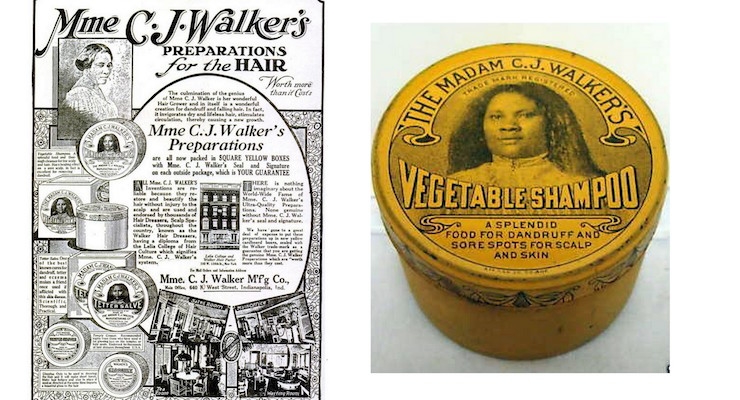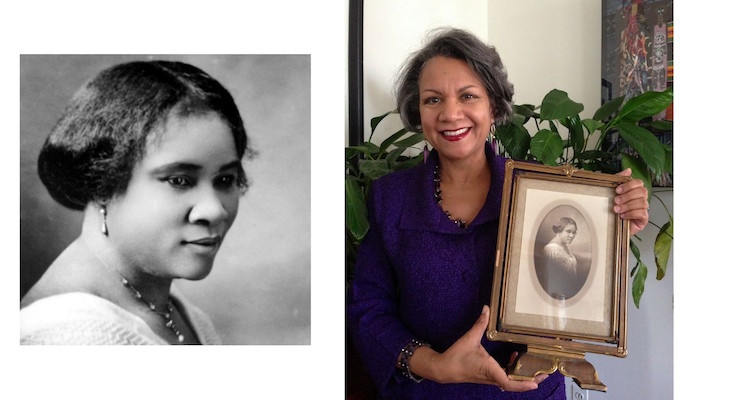Marie Redding, Associate Editor06.29.16
Sundial Brands recently launched the hair care line Madam C.J. Walker Beauty Culture at Sephora, and is tapping into the multicultural beauty trend by not labeling it as an “ethnic” brand. The line pays homage to Madam C.J. Walker, who was one of the first female entrepreneurs in the beauty business. Walker is credited with establishing herself as a pioneer of the modern black hair-care industry.
Richelieu Dennis, founder, Sundial Brands, explains, “We created this brand to be timeless – both in ideals and aesthetic. It is a brand and a legacy that is iconic, so we didn’t need to look at trends as much as we looked at what its defining elements were, through the years. Then, we reimagined these qualities to appeal to today’s consumer.”
Photos in the slideshow above: The Madam C.J. Walker Beauty Culture line; Silkening products, left, with Curl Gel and Clarifying Shampoo, right; Treatment products, left, with Frizz-Fighting products, right; an original newspaper ad for Walker's products, left, vintage tin for Vegetable Shampoo (sold on ebay), right; vintage Scalp Ointment, left, with two vintage cartons, which show how elements from the original packaging inspired the current design; Madame C.J. Walker on left, and on the right is Walker's great-granddaughter, A'Lelia Bundles, holding up a framed photo of her great-grandmother.
About The Products & Dual Encapsulated Oils
The prestige line includes many products formulated to tame frizz, block humidity and hydrate curls, but it is being marketed to all women, with any type of hair, especially dry. The products will help style all types of looks, from straight to wavy, as well as the curliest locks.
“Our revolutionary new products and cutting edge formulations provide women with all hair textures with a new standard of beauty – their own,” says Dennis.
The products are the first to feature dual encapsulation technology in their formulas. This infuses the hair with two natural oils—one reparative, one style enhancing—while delivering time-release nutrients to boost conditioning benefits. The encapsulated oil combinations include Brassica Seed & Shea Oils, Coconut & Moringa Oils and Jamaican Black Castor & MuruMuru Oils.
Colorful, Stylish Packaging
The Madam C.J. Walker line consists of plastic bottles, tubes and jars, grouped into four color-coded collections: Maximum Moisture is a bright mustard yellow hue; Tame Frizz is pretty eggshell blue; Smooth Style is a bright mauve pink; and Nourish & Restore is a violet-lavender. The colors look modern, and many of the packages are paired with shiny silver caps.
Dennis tells us in the feature story, What’s Happening in Hair Care?, that the colors were chosen to look “different,” and set the brand apart from all others in the hair care aisle. The packaging was designed by ROOK, based in Brooklyn.
The brand’s logo uses vintage style lettering as a nod to the past—take a look at it in the slideshow above, next to one of the original Madam C.J. Walker products, and its packaging.
Inspired by History
Madam C.J. Walker was born Sarah Breedlove, and her parents were slaves. She worked in the cotton fields in Mississippi until marrying at 14 years old. Her husband died two years later, and she moved to St. Louis to work in a barbershop with her four brothers, where she experimented with creating homemade hair remedies. In 1905 she moved to Denver to work as a sales agent for Annie Malone, another black woman entrepreneur.
Around this time, she married her third husband, Charles Joseph Walker, changed her name, and launched her first product, “Madam Walker’s Wonderful Hair Grower,” a scalp conditioning formula that she created to solve her hair issues. She sold her products door-to-door.
In 1908, she opened Lelia College in Pittsburgh, named after her daughter, A’Lelia, where she trained “hair culturists.” In 1910, Walker opened a factory, hair and manicure salon and another training school in Indianapolis.
In 1916, she moved to New York City’s Harlem neighborhood, where she became more involved in politics and fought for equal rights. In 1917, she held what was considered to be one of the first national meetings of businesswomen in the country, in Philadelphia—the Madam C. J. Walker Hair Culturists Union of America convention. Walker rewarded her sales agents, while also encouraging political activism.
Read more about her history here, as told by A’Lelia Bundles, Madam C.J. Walker’s great-granddaughter.
Continuing a Legacy
Dennis says his goal was to elevate Walker’s legacy and is proud to have accomplished this. He explains, “This line continues Madam C.J. Walker’s legacy of women’s and economic empowerment. She was the first person to devise and scale a business model that addressed the hair care and beauty needs of women of color, while also challenging the myopic ideals of the beauty industry at that time. This launch has been almost a decade endeavor for us, from when we first thought that honoring her legacy in this way was possible, to now introducing this brand to a new generation.”
Dennis adds, “We’re bringing back more than a brand. We are introducing what ‘beauty culture’ means to a new generation, and building on what Madam Walker did more than 100 years ago.”
Dennis says that the company will continue the mission to create educational platforms and opportunities for women, while providing solutions that meet the many different needs of women with all hair types and textures. He says, “Our new products and formulas use the best ingredients and technology of our time, just as Madam C.J. Walker did.”
Richelieu Dennis, founder, Sundial Brands, explains, “We created this brand to be timeless – both in ideals and aesthetic. It is a brand and a legacy that is iconic, so we didn’t need to look at trends as much as we looked at what its defining elements were, through the years. Then, we reimagined these qualities to appeal to today’s consumer.”
Photos in the slideshow above: The Madam C.J. Walker Beauty Culture line; Silkening products, left, with Curl Gel and Clarifying Shampoo, right; Treatment products, left, with Frizz-Fighting products, right; an original newspaper ad for Walker's products, left, vintage tin for Vegetable Shampoo (sold on ebay), right; vintage Scalp Ointment, left, with two vintage cartons, which show how elements from the original packaging inspired the current design; Madame C.J. Walker on left, and on the right is Walker's great-granddaughter, A'Lelia Bundles, holding up a framed photo of her great-grandmother.
About The Products & Dual Encapsulated Oils
The prestige line includes many products formulated to tame frizz, block humidity and hydrate curls, but it is being marketed to all women, with any type of hair, especially dry. The products will help style all types of looks, from straight to wavy, as well as the curliest locks.
“Our revolutionary new products and cutting edge formulations provide women with all hair textures with a new standard of beauty – their own,” says Dennis.
The products are the first to feature dual encapsulation technology in their formulas. This infuses the hair with two natural oils—one reparative, one style enhancing—while delivering time-release nutrients to boost conditioning benefits. The encapsulated oil combinations include Brassica Seed & Shea Oils, Coconut & Moringa Oils and Jamaican Black Castor & MuruMuru Oils.
Colorful, Stylish Packaging
The Madam C.J. Walker line consists of plastic bottles, tubes and jars, grouped into four color-coded collections: Maximum Moisture is a bright mustard yellow hue; Tame Frizz is pretty eggshell blue; Smooth Style is a bright mauve pink; and Nourish & Restore is a violet-lavender. The colors look modern, and many of the packages are paired with shiny silver caps.
Dennis tells us in the feature story, What’s Happening in Hair Care?, that the colors were chosen to look “different,” and set the brand apart from all others in the hair care aisle. The packaging was designed by ROOK, based in Brooklyn.
The brand’s logo uses vintage style lettering as a nod to the past—take a look at it in the slideshow above, next to one of the original Madam C.J. Walker products, and its packaging.
Inspired by History
Madam C.J. Walker was born Sarah Breedlove, and her parents were slaves. She worked in the cotton fields in Mississippi until marrying at 14 years old. Her husband died two years later, and she moved to St. Louis to work in a barbershop with her four brothers, where she experimented with creating homemade hair remedies. In 1905 she moved to Denver to work as a sales agent for Annie Malone, another black woman entrepreneur.
Around this time, she married her third husband, Charles Joseph Walker, changed her name, and launched her first product, “Madam Walker’s Wonderful Hair Grower,” a scalp conditioning formula that she created to solve her hair issues. She sold her products door-to-door.
In 1908, she opened Lelia College in Pittsburgh, named after her daughter, A’Lelia, where she trained “hair culturists.” In 1910, Walker opened a factory, hair and manicure salon and another training school in Indianapolis.
In 1916, she moved to New York City’s Harlem neighborhood, where she became more involved in politics and fought for equal rights. In 1917, she held what was considered to be one of the first national meetings of businesswomen in the country, in Philadelphia—the Madam C. J. Walker Hair Culturists Union of America convention. Walker rewarded her sales agents, while also encouraging political activism.
Read more about her history here, as told by A’Lelia Bundles, Madam C.J. Walker’s great-granddaughter.
Continuing a Legacy
Dennis says his goal was to elevate Walker’s legacy and is proud to have accomplished this. He explains, “This line continues Madam C.J. Walker’s legacy of women’s and economic empowerment. She was the first person to devise and scale a business model that addressed the hair care and beauty needs of women of color, while also challenging the myopic ideals of the beauty industry at that time. This launch has been almost a decade endeavor for us, from when we first thought that honoring her legacy in this way was possible, to now introducing this brand to a new generation.”
Dennis adds, “We’re bringing back more than a brand. We are introducing what ‘beauty culture’ means to a new generation, and building on what Madam Walker did more than 100 years ago.”
Dennis says that the company will continue the mission to create educational platforms and opportunities for women, while providing solutions that meet the many different needs of women with all hair types and textures. He says, “Our new products and formulas use the best ingredients and technology of our time, just as Madam C.J. Walker did.”





















